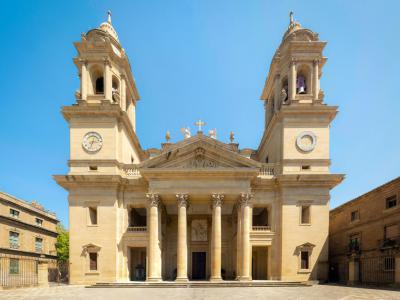
Catedral de Pamplona (Pamplona Cathedral), Pamplona (must see)
The Pamplona Cathedral is a captivating blend of architectural styles that reflects centuries of history in PamplonaInitially built upon the ruins of a 12th-century Romanesque church, the Cathedral evolved over time, becoming a significant stop along the medieval pilgrimage route to Santiago de Compostela. Its main structure, predominantly Gothic in style, dates back to the 14th and 15th centuries, while the Neoclassical facade, completed in 1799, adds a striking visual element with its towering twin towers that dominate the skyline.
Inside, visitors are greeted by a grandiose Gothic sanctuary adorned with intricate details and housing notable treasures such as the alabaster tomb of Charles III the Noble and his wife Leonora de Trastámara, crafted by Flemish master Jean de Lomme. The Capilla Mayor, or Main Chapel, boasts an exquisite Gothic retablo from 1507, showcasing fine sculptural craftsmanship. Additionally, the south aisle features a richly gilded doorway displaying the 14th-century tympanum Death of the Virgin, leading to the Claustro (Cloister), celebrated as one of Spain's finest medieval Gothic cloisters.
Preserving its Romanesque origins, the cathedral houses a crypt from the original church, along with a precious 12th-century carved figure of the Virgin Mary, symbolizing its enduring spiritual significance. For those eager to delve deeper into its treasures, the Diocesan Museum offers a fascinating journey through the cathedral's history, with lavishly decorated refectories and rooms displaying sacred art, including a 13th-century Gospel book and relics believed to include a fragment of the True Cross.
Inside, visitors are greeted by a grandiose Gothic sanctuary adorned with intricate details and housing notable treasures such as the alabaster tomb of Charles III the Noble and his wife Leonora de Trastámara, crafted by Flemish master Jean de Lomme. The Capilla Mayor, or Main Chapel, boasts an exquisite Gothic retablo from 1507, showcasing fine sculptural craftsmanship. Additionally, the south aisle features a richly gilded doorway displaying the 14th-century tympanum Death of the Virgin, leading to the Claustro (Cloister), celebrated as one of Spain's finest medieval Gothic cloisters.
Preserving its Romanesque origins, the cathedral houses a crypt from the original church, along with a precious 12th-century carved figure of the Virgin Mary, symbolizing its enduring spiritual significance. For those eager to delve deeper into its treasures, the Diocesan Museum offers a fascinating journey through the cathedral's history, with lavishly decorated refectories and rooms displaying sacred art, including a 13th-century Gospel book and relics believed to include a fragment of the True Cross.
Want to visit this sight? Check out these Self-Guided Walking Tours in Pamplona. Alternatively, you can download the mobile app "GPSmyCity: Walks in 1K+ Cities" from Apple App Store or Google Play Store. The app turns your mobile device to a personal tour guide and it works offline, so no data plan is needed when traveling abroad.
Catedral de Pamplona (Pamplona Cathedral) on Map












Sight Name: Catedral de Pamplona (Pamplona Cathedral)
Sight Location: Pamplona, Spain (See walking tours in Pamplona)
Sight Type: Attraction/Landmark
Guide(s) Containing This Sight:
Sight Location: Pamplona, Spain (See walking tours in Pamplona)
Sight Type: Attraction/Landmark
Guide(s) Containing This Sight:
Walking Tours in Pamplona, Spain
Create Your Own Walk in Pamplona
Creating your own self-guided walk in Pamplona is easy and fun. Choose the city attractions that you want to see and a walk route map will be created just for you. You can even set your hotel as the start point of the walk.
Pamplona Introduction Walking Tour
Pamplona, the capital of the autonomous region of Navarre in northern Spain, is one of the oldest cities in the country. Its history spans millennia. Originally a small Vascones settlement known as Iruña, it was transformed into a Roman city named Pompelo by the Roman commander Gnaeus Pompey in 74 BC. Over the centuries, Pamplona witnessed the rise and fall of various powers, from the Visigoths... view more
Tour Duration: 2 Hour(s)
Travel Distance: 2.8 Km or 1.7 Miles
Tour Duration: 2 Hour(s)
Travel Distance: 2.8 Km or 1.7 Miles

